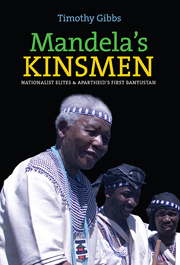Book contents
- Frontmatter
- Contents
- List of Maps and Figures
- Acknowledgements
- List of Abbreviations
- Introduction: Mandela' Kinsmen
- 1 Education, Monarchy & Nationalism
- 2 The First Bantustan, 1954–1963
- 3 The Second Peasants' Revolt, Mpondoland 1960–1980
- 4 The Old Mission Schools, 1963–1980
- 5 The Comrade-King, Bantustan Politics 1964–1980
- 6 Chris Hani's Guerrillas, 1974–1987
- 7 The Apartheid Endgame, 1987–1996
- 8 The New South Africa & Transkei's Collapse, 1990 onwards
- Conclusion: African Nationalism & its Fragments
- Bibliography
- Index
2 - The First Bantustan, 1954–1963
Published online by Cambridge University Press: 05 April 2014
- Frontmatter
- Contents
- List of Maps and Figures
- Acknowledgements
- List of Abbreviations
- Introduction: Mandela' Kinsmen
- 1 Education, Monarchy & Nationalism
- 2 The First Bantustan, 1954–1963
- 3 The Second Peasants' Revolt, Mpondoland 1960–1980
- 4 The Old Mission Schools, 1963–1980
- 5 The Comrade-King, Bantustan Politics 1964–1980
- 6 Chris Hani's Guerrillas, 1974–1987
- 7 The Apartheid Endgame, 1987–1996
- 8 The New South Africa & Transkei's Collapse, 1990 onwards
- Conclusion: African Nationalism & its Fragments
- Bibliography
- Index
Summary
King Sabata and the Great Place Gang
In the 1950s, the Thembu kingdom was in the midst of a dispute – the chieftaincy split over the figure of King Sabata Dalindyebo (b.1928), the young paramount chief installed in 1954. Chieftaincy disputes were not unusual, but in the 1950s these clashes carried much broader significance. This was the decade in which apartheid government legislation laid the foundations for the creation of Bantustan self-governing territories, which followed in the 1960s. The Bantu Authorities Act of 1951 was unpopular because it established a system of Tribal Authorities: new tiers of segregated, local ‘tribal’ administration in which government-appointed chiefs took new powers. Most importantly, these new Tribal Authorities were used to force through rural Betterment schemes. These policies forcibly resettled scattered homesteads into concentrated villages, culled cattle and fenced in arable fields in an attempt to increase agricultural productivity. It ‘constituted perhaps the most far reaching intervention into rural life since annexation and the introduction of taxes.’ Across South Africa, rural protests followed.
Traditional leaders throughout Transkei found themselves caught between popular protests and the apartheid government. Under these pressures many chieftaincies fractured along myriad lines. In Eastern Mpondoland a large revolt broke out against the incumbent king, Botha Sigcau, who had backed apartheid measures to the hilt. (This is discussed in more detail in Chapter Three.) In the most northern districts of Thembuland where the most powerful traditional leader, Kaiser Matanzima, had similarly aligned his fortunes with the apartheid government, local protestors were known as the Jacobins (amayakopu) and Makhuluspani (Big Team).
- Type
- Chapter
- Information
- Mandela's KinsmenNationalist Elites and Apartheid's First Bantustan, pp. 25 - 47Publisher: Boydell & BrewerPrint publication year: 2014



